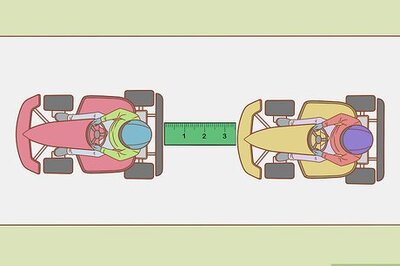
views
LOS ANGELES: California Democrats appear to have come away with the advantage in a recasting of the states congressional districts, with boundaries that could strengthen their hold on the delegation and play into the fight for U.S. House control next year.
Still, the new maps left a string of competitive seats that make California something of an outlier in a nation of deeply divided politics: Even though its a Democratic stronghold, the new maps suggest Republicans might pull off surprises.
Democrats are defending a fragile eight-seat House majority in a midterm election, when the party that controls the White House typically loses seats in Congress and President Joe Bidens approval ratings have been shaky.
Redistricting fights have been playing out across the country, as Democrats and Republicans look for an edge in future elections. The Justice Department recently sued Texas over its new redistricting maps, saying the plans discriminate against Latinos and other minority voters.
While California is losing one seat for the first time in its history because the population in other states is growing faster, Texas, Florida, Colorado and North Carolina are among the states gaining seats.
An analysis by Sacramento research firm Redistricting Partners found that 44 of the new California House districts would have been carried by Democratic Gov. Gavin Newson in his 2018 election, and 45 of the districts tilted to then-candidate Biden in the 2020 presidential race.
Thats an encouraging sign for Democrats, who hope to gain ground in California in 2022 after surrendering four House seats to Republicans in 2020. Democrats hold 42 of the states 53-seat House delegation the largest delegation by far in Congress.
The revised lines were endorsed Monday by the California Citizens Redistricting Commission, which was tasked with drawing new districts to account for shifts in population, a requirement that happens once a decade. Each district must represent 760,000 people.
Republican National Committee spokeswoman Hallie Balch said the panel had created cakewalk districts for most Democrats.
Californias redistricting committee has entirely lost track of the people who reside in the districts they have drawn, Balch said in a statement. These lines are a disappointing end to a long-fought battle for representation.
The shuffling of the district borders already has resulted in changes in the delegation.
Long-serving California Rep. Lucille Roybal-Allard, the first Mexican-American woman elected to Congress, announced Monday she will not seek reelection in her Los Angeles-area district. The decision by the 80-year-old Democratic congresswoman came as her district was largely dismantled by the commission.
Shifting district boundary lines appear to have played a role in other House departures. Among them: Republican Rep. Devin Nunes, who was one of former President Donald Trumps most ardent loyalists in Congress, is leaving the House at the end of this year to join Trumps fledgling media company, and Democratic Rep. Alan Lowenthal, who represents a district anchored in Long Beach, south of Los Angeles, announced he would retire at the end of his term.
The ripple effects continue, and some candidates in key races could shift to nearby districts in search of a more favorable political climate. Republican U.S. Reps. Young Kim and Michelle Steel, who captured Democratic seats all or partly in Orange County in 2020, have yet to announce their plans.
However, the shifting lines had little effect on the state’s marquee names in the House. House Speaker Nancy Pelosi’s overwhelmingly Democratic district anchored in San Francisco remained overwhelmingly Democratic. House Republican leader Kevin McCarthy’s district, anchored in Bakersfield, became more solidly Republican in the new maps.
While most attention has focused on Californias loss of a congressional seat, analysts said the legislative maps drawn for 40 state senators and 80 state Assembly members mark big wins for Democrats.
The maps essentially lock in Democratic supermajorities for the next 10 years, said Rob Pyers, research director of the nonpartisan California Target Book, which closely tracks redistricting.
Republicans have been teetering on the brink of irrelevance in the heavily Democratic state for years, and Democrats control every statewide office and dominate the Legislature and congressional delegations. Republicans make up less than a quarter of registered voters, and have lost support in what used to be Republican-leaning suburbs, said Mitchell, of Redistricting Partners.
The new lines will have a chilling effect on Republican hopes of gaining ground in the Legislature, Mitchell said.
The new lines also recognize the state’s increasing diversity.
Mitchell said Latinos, the largest racial or ethnic group in California, now represent majorities in 16 House districts. Three districts group together areas with large Asian populations, and two do the same for communities with large numbers of Black residents.
The borders of Fresno area districts represented by Democratic Rep. Jim Costa and Republican Reps. David Valadao and Devin Nunes shifted significantly. Costa on Tuesday announced he would run in the new 21st District, anchored in the Central Valley.
___
Associated Press Writer Don Thompson in Sacramento contributed.
Disclaimer: This post has been auto-published from an agency feed without any modifications to the text and has not been reviewed by an editor
Read all the Latest Politics News here




















Comments
0 comment